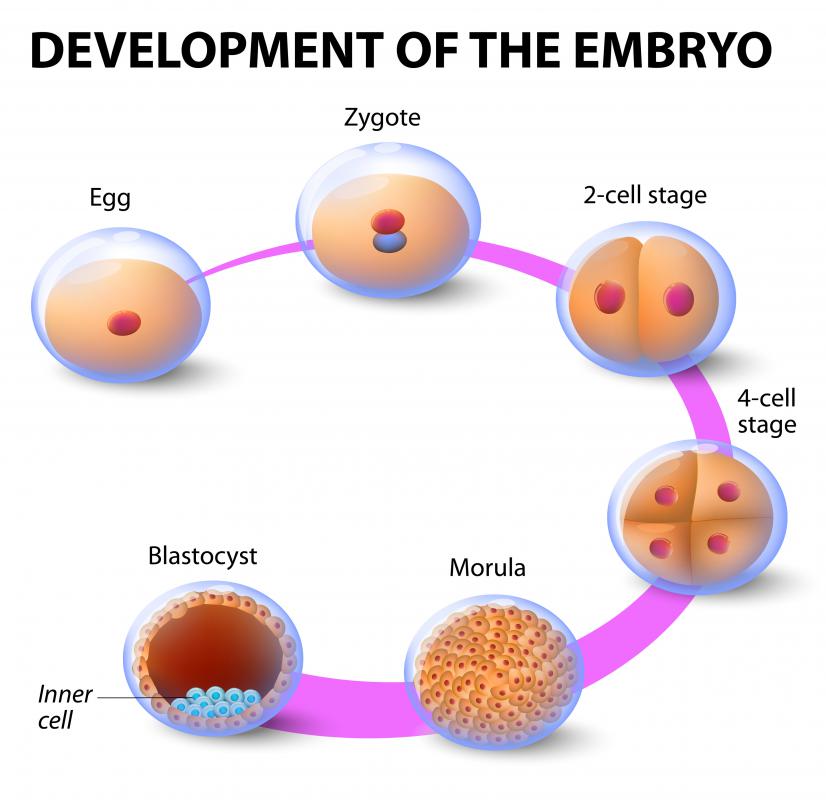At WiseGEEK, we're committed to delivering accurate, trustworthy information. Our expert-authored content is rigorously fact-checked and sourced from credible authorities. Discover how we uphold the highest standards in providing you with reliable knowledge.
What Is Ontogeny?
Ontogeny refers to the course of an organism's development from inception to adulthood. The cycle begins at fertilization and is complete when the organism attains physical and sexual maturity. As a subject of study in biology, ontogeny is concerned with the developmental process of an individual member of a species within its own lifetime. The evolutionary development of an entire species is the subject matter of phylogeny.
The process of human ontogeny begins with the fusion of the male and female gametes to form a zygote with a full set of human chromosomes. This is said to be the beginning of an ontogenetic cycle. The single cell will grow into a unique individual organism by mitoses, a series of asexual reproductions. The population of a species is made up of individuals at varying stages of the ontogenetic cycle.

In single-celled organisms, mitoses normally lead to the formation of independent, genetically identical individuals. In multicellular organisms, the initial products of the mitoses are genetically equivalent, but the cells remain connected and later differentiate to form a unique individual. The ontogeny of multicellular organisms is that the successive generations of cells derived from the zygote differentiate into tissues and organs. This process leads to the development of an embryo.

An embryo can continue to develop in a number of different contexts, depending on species. The path to the juvenile stage may also be direct or through an intermediate form. Development continues through the juvenile stage until the organism reaches its physical and sexual maturity in adulthood. At this point, ontogeny usually stops.
The ontogeny of an organism is sometimes depicted as an inverted cone. At the bottom of the cone is the single celled zygote, which contains the potential to produce an adult organism. Each successive step in development mitigates the range of possible actions in subsequent steps, and is represented by an increase in the height and diameter of the cone. A mutation early in the ontogentic cycle will have much greater consequences than one occurring later. This visualization helps biologists examine the effect a viable mutation might have at various stages in an organism's life.
Comprising the developmental lifetime of an organism, ontogeny necessarily touches on many aspects of biology. Various disciplines in biology are defined by significant periods within the ontogentic cycle. Embryology is concerned with the period from fertilization to the beginning of independent individual development, for example. The genetic regulation of the cycle over its course is the subject of developmental genetics. Life cycle biologists identify the sequence and qualitative nature of stages in an ontogentic cycle.
AS FEATURED ON:
AS FEATURED ON:












Discussion Comments
@MrsWinslow - I actually came across the same idea that life begins at primitive streak formation in a science fiction novel, of all places! I can't remember the name of it but the author was Robert J. Sawyer. In this future, the US had banned abortion after primitive streak formation (and almost no one knows they're pregnant before that point) with the idea that life begins at the moment when it is no longer for a cell cluster to become two people; it is then an individual.
I remember learning that "ontogeny recapitulates phylogeny" in my college bio classes. I think it really just means embryonic development, but the idea is that embryonic development sort of re-traces an organism's evolution. That's why you occasionally see a human baby born with a tail, webbed fingers, or gill slits - these are stages in embryonic development that are passed through, just as humankind's ancestors had these traits and then evolved to lose them.
I've heard that some evolutionary biologists and embryologists think that a really important stage in development happens maybe ten days after fertilization - they call it "primitive streak formation." Basically, before that all you have is a ball of cells with no up or down or differentiation of any kind. In fact, the ball of cells could still split in two to form identical twins, so it cannot really be said to be an "individual."
But at this early point, a sort of divit starts to form in the ball of cells, a line that will eventually become the backbone. Now there is an up and a down, and now the ball of cells is definitely only one individual.
I read about one scientist who works with embryos that are created and discarded in the effort toward therapeutic cloning. He says that he is totally comfortable working with very early embryos, but would *never* work with (i.e., destroy) one after primitive streak formation, as that is when he believes life begins.
Post your comments